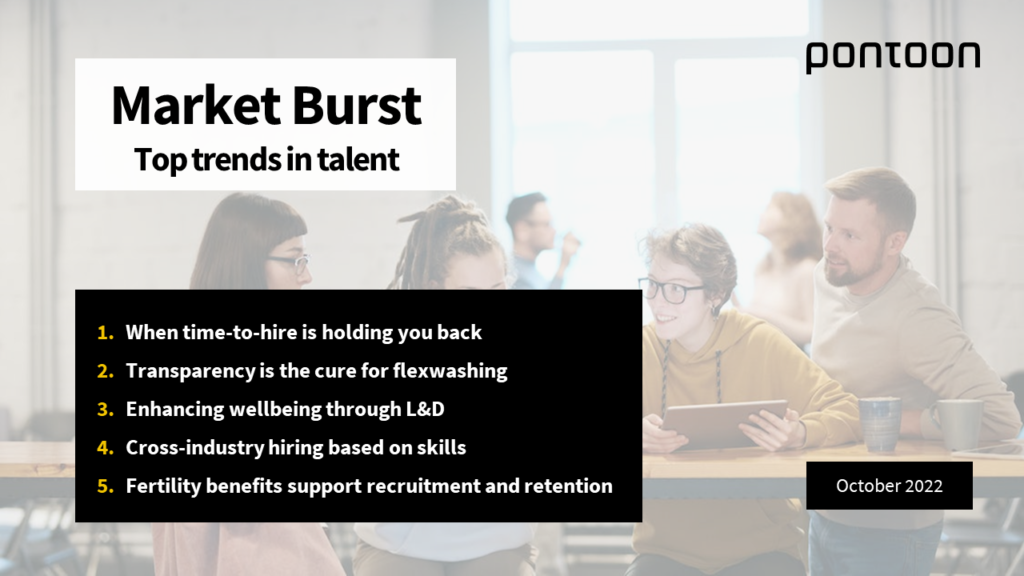Market Burst: October 2022
Read about top trends in the world of work.
In this month’s instalment of our Market Burst, we dive into the importance of time-to-hire, enhancing wellbeing through L&D, dangers of flexwashing and more. Have a read below.
When time-to-hire is holding you back
Candidates are losing patience with convoluted, long hiring processes. The average time-to-hire is 43 days, often with multiple interviews during this period; but almost 8 in 10 applicants lose interest if they have not heard back within three weeks.
When 40% of employers report hiring challenges due to a lack of available talent, the danger is clear: if your hiring process is too long, you risk losing the strongest talent to competitors.
How can you shorten your time-to-hire? The first step is to consider how many stages in your existing process are strictly necessary. Do you need multiple interviews to tell if a candidate is a right fit? Can multiple aptitude and skills tests be consolidated into one? Employers need to ask these questions in a market where talent is hard to find and not available for too long.
Streamlining shouldn’t stop there. New technologies enable automation of stages like onboarding communications and skills testing which considerably accelerate time-to-hire.
Responsiveness remains key. Candidates need a single point of contact for queries, but that alone won’t help if responses are slow or unhelpful. Fast, transparent responses, combined with a professional and gregarious tone will keep applicants interested and excited to work for you.
Transparency is the cure for flexwashing
Flexible working is here to stay, but the lack of any standard definition of flexible and remote work has led to grey areas and misunderstandings. Companies realise that 63% of employees prefer a hybrid working environment that allows for easier alignment of work and home responsibilities. Frontline workers also prioritise flexibility, seeking cultures that promote different work schedules or time off for holidays. However, some organisations are addressing this pressing need through “flexwashing” rather than meeting their employees’ expectations.
The recently coined term – flexwashing – can refer to different practises. It can denote employers’ practise of entirely misrepresenting flexible and work-from-home policies during recruitment to attract talent. It can also mean work policies that aren’t truly flexible, i.e. they don’t allow for autonomy to choose where and when to work by mandating certain days of the week as office-bound. One recent example is Apple’s decision to require employees to work in-office three day a week. New hires may feel as if they were onboarded under false pretences which leads to instant disengagement. Studies show that a flexible schedule is more important than salary to nearly half of employees and 36% value flexibility more than their PTO.
Employers who follow this practice risk a bad reputation, as news among job seekers travel fast. To avoid damaging their employer brand, firms must be transparent about their hybrid, remote, and flexible working policies. Details of what is considered flexible in each workplace should be easily accessible, with fairness and transparency at their core. A clear system of checks and balances, like CRM company HubSpot has implemented, can resolve disputes and prevent ambiguity.
Enhancing wellbeing through L&D
Work-related anxiety is widespread. According to recent studies, 4 in 10 respondents said they suffer from imposter syndrome at work. Interestingly, 36% pointed to an intriguing solution, admitting they feel held back by the lack of a learning management system (LMS) for self-paced development.
Self-managed learning and development (L&D) empowers employees to take control of developing skills crucial to feeling more confident in their jobs. An essential and often-overlooked aspect is that it also allows to complete courses that might not always have a direct workplace application yet can help employees better manage their stress.
Organisations should recognise that workplace-related anxiety is a major driver of disengagement and instil a culture of continuous learning. Learning and development initiatives and tools need to go beyond reskilling and upskilling. An LMS that features courses on areas such as time management, preventing burnout, and mindfulness can help your people achieve a healthier work-life balance and improve their productivity.
Cross-industry hiring based on skills
The Great Resignation isn’t over – 40% of workers surveyed by McKinsey still plan to leave their jobs in the next six months. New studies also reveal that many workers who decided to change employers recently, were dissatisfied not only with their jobs but also with their industry.
Only 35% of leavers in the last two years have stayed in the same industry, while nearly 5 in 10 have found a job in a different area. This degree of cross-industry churn is effectively a “great reshuffle” and needs a diversified approach from employers. It’s time to focus on skills rather than experience. Firms must understand that they’re no longer competing for talent just within their industry. Insisting on sector experience rules out talent with transferable skills from other fields.
The winners of the Great Reshuffle will be organisations with a clear idea of the skills they need. The exodus is not evenly spread among sectors. For example, 72% of those leaving the public and non-profit sectors did not return to it. This means that forward-thinking employers can get a head start on their competition by identifying industries that have a high number of leavers with transferable skills – these individuals can be actively targeted for recruitment.
Fertility benefits support talent attraction and retention
In the United States, fertility issues affect one in eight couples, yet 80% of people who undergo in-vitro fertilisation (IVF) have hardly any or no coverage for such treatments. In a recent US survey by Carrot Fertility and RESOLVE, only 6% of respondents felt adequately supported by their workplace in their family-forming journey. But this is not just a US issue. Even in countries with public healthcare systems, the criteria for access to fertility treatment often disqualify those in need.
Workers are willing to change jobs over this; in fact, 88% said they would consider changing jobs for better fertility benefits. This is not just an insurance coverage issue but also a recruitment and retention issue. When the right talent is becoming harder than ever to find, employers can’t afford to ignore this.
Firms must destigmatise the fertility conversation. This means including fertility treatment among your benefits and publicising them. According to research by Mercer, 97% of companies that offer fertility benefits reported no significant increase in costs. Coverage should be as broad as possible and must not discriminate based on relationship status, gender identity, sexuality, and related factors.
Related Post
Quiet quitting took social media by storm and sparked a heated debate. Many now see quiet quitting as a way to set healthy professional boundaries. Quiet quitters are finding empowerment ...





